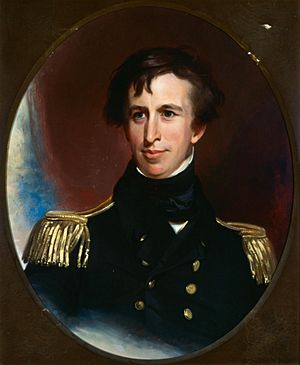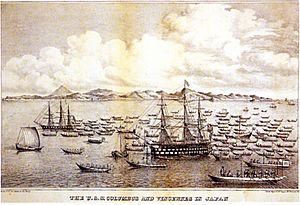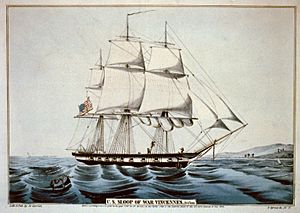USS Vincennes (1826) facts for kids

A painting from the 1800s showing USS Vincennes in Disappointment Bay, Antarctica, around 1840.
|
|
Quick facts for kids History |
|
|---|---|
| Name | USS Vincennes |
| Namesake | A city in Indiana, known for American Revolution battles. |
| Builder | Brooklyn Navy Yard |
| Laid down | 1825 |
| Launched | 27 April 1826 in New York City |
| Commissioned | 27 August 1826 at New York City |
| Decommissioned | 28 August 1865 at the Boston Navy Yard |
| Stricken | 1867 (est.) |
| Fate | Sold, 5 October 1867, at Boston, Massachusetts |
| General characteristics | |
| Class and type | Boston-class sloop-of-war |
| Displacement | 700 long tons (711 t) |
| Length | 127 ft (39 m) p/p |
| Beam | 33 ft 9 in (10.29 m) |
| Draft | 16 ft 6 in (5.03 m) |
| Propulsion | Sail |
| Speed | 18.5 knots (rated) |
| Complement | 80 |
| Armament | 18 guns |
The USS Vincennes (1826) was a 703-ton warship called a sloop of war. It served in the United States Navy from 1826 to 1865. During its time, Vincennes sailed the Pacific Ocean, explored the Antarctic, and helped block the Confederate Gulf coast during the American Civil War.
The ship was named after the American Revolutionary War Battle of Vincennes. It was also the first U.S. warship to sail all the way around the world.
Contents
Building the USS Vincennes
The Vincennes was the first American ship to have this name. It was one of ten sloops of war that the Congress approved on March 3, 1825.
The ship was built at the Brooklyn Navy Yard in 1825. It was launched into the water on April 27, 1826, and officially started service on August 27, 1826. William Compton Bolton was its first commander.
First Trip Around the World
The ship began its first journey on September 3, 1826. It sailed from New York to the Pacific Ocean by going around Cape Horn. It traveled widely in the Pacific, visiting the Hawaiian Islands in 1829.
By 1830, the ship reached Macau under Commander William B. Finch. Its trip back included sailing through China, the Philippines, the Indian Ocean, and around the Cape of Good Hope. After almost four years, Vincennes returned to New York on June 8, 1830. This made it the first U.S. Navy ship to sail completely around the Earth.
Trips to the West Indies and Guam
After being repaired and put back into service, Vincennes sailed in the West Indies and the Gulf of Mexico in 1831–1832. It was part of the West Indies Squadron. The ship was taken out of service again in 1833 due to many crew members getting sick with yellow fever.
It then left for a second trip to the Pacific in 1833. On this journey, it became the first American warship to visit Guam. The ship sailed around the world again, returning to the U.S. East Coast in June 1836.
Helping the Wilkes Expedition

Vincennes was taken out of service again in 1836 for major changes. It was refitted with a lighter upper deck and became the main ship, or flagship, for the United States Exploring Expedition. This expedition was set to explore the Antarctic region.
Led by Lieutenant Charles Wilkes, the expedition left Hampton Roads in August 1838. They surveyed parts of the South American coast before a quick survey of Antarctica in early 1839. In August and September 1839, they entered the South Pacific. The maps they drew of this area are still used today.
After more surveys and scientific work in South America and the South Pacific, Vincennes arrived in Sydney, Australia, in late 1839. This was its base for a trip to Antarctica. The ship even slipped into Sydney Harbour unnoticed, showing how weak the harbor's defenses were. From mid-January to mid-February 1840, it sailed along the icy coast of Antarctica. This coast is now known as Wilkes Land, named after Lieutenant Wilkes.
The rest of this long journey included visits to islands in the South Pacific, Hawaii, the Columbia River area, Puget Sound, California, Wake Island, the Philippines, and South Africa. This third trip around the world ended in New York in June 1842.
Operations from 1842 to 1847
Vincennes was then assigned to the Home Squadron. It was commanded by Commander Franklin Buchanan, who later became the first leader of the United States Naval Academy. The ship sailed to the West Indies and off the Mexican coast until the summer of 1844.
During this time, Vincennes rescued two English brigs (a type of sailing ship) that were stuck off the coast of Texas. The British government thanked the ship for this help. Buchanan was also told to stop any invasion of the new Republic of Texas by Mexico. This invasion never happened, and Vincennes returned to Hampton Roads on August 15, 1844.
On June 4, 1845, Vincennes sailed to the Far East under Captain Hiram Paulding. It traveled with the ship-of-the-line Columbus. These two ships formed a small group led by Commodore James Biddle. Commodore Biddle carried a letter from Secretary of State John C. Calhoun. This letter allowed Caleb Cushing, the American commissioner in China, to make the first official contact with the Japanese Government.

The ships sailed to Macau by way of Rio de Janeiro and the Cape of Good Hope. Commodore Biddle found that Cushing had already left, and his replacement was too sick. So, Biddle decided to handle the talks himself.
Vincennes and Columbus sailed to Japan on July 7, 1846. They dropped anchor off Uraga on July 19. The Japanese surrounded the ships and did not let anyone come ashore. However, they treated the visitors politely. Commodore Biddle tried to open Japan to trade, but the Japanese politely refused. The ships left on July 29. Columbus went back to the United States, but Vincennes stayed in China for another year. It returned to New York on April 1, 1847, and was taken out of service on April 9.
Operations from 1849 to 1860
Vincennes was out of service until 1849. It was put back into service on November 12, 1849. Exactly one month later, it sailed from New York towards Cape Horn and the west coast of South America. On July 2, 1850, while near Guayaquil, Ecuador, it gave shelter to the Ecuadorian revolutionary General Jorge Antonio Elizalde for three days during a time of unrest in that country.
Sailing on to San Francisco, California, the ship lost 36 crew members. They left the ship because of the gold fever that was happening in California. Vincennes then sailed south, patrolling off South America until late 1851. It watched the activities of revolutionaries on land very closely.
At the end of 1851, it made a friendly visit to the Hawaiian Islands. Then it went to Puget Sound, arriving on February 2, 1852. After a short stop, it returned to New York by way of San Francisco and Cape Horn. It arrived on September 21 and was taken out of service on September 24.
After repairs, Vincennes was put back into service on March 21, 1853. It sailed to Norfolk, Virginia, on May 13 to join its second exploration trip. It was the flagship for Commander Cadwalader Ringgold's survey of the South China Sea, the North Pacific, and the Bering Strait. Commander Ringgold had been on the Wilkes expedition before. The ships left Norfolk on June 11, 1853. They went around the Cape of Good Hope and mapped many islands and shallow areas in the Indian Ocean before reaching China in March 1854.
In China, Commodore Matthew C. Perry took over from Ringgold due to medical reasons. He gave command of the expedition to Lieutenant John Rodgers. Vincennes sailed on to survey the Bonin Islands and Ladrone Islands. It returned to Hong Kong in February 1855. The expedition sailed again in March and surveyed islands between the Ryūkyū chain and Japan, and then the Kurils.
Vincennes left the other ships at Petropavlovsk, Russia. It entered the Bering Strait, sailing northwest towards Wrangel Island. Ice blocked the ship from reaching this island, but it got closer than any ship before it. Vincennes returned to San Francisco in early October. Later, it sailed around Cape Horn and back to New York, arriving on July 13, 1856. This completed another trip around the world.
From 1857 to 1860, Vincennes worked with the African Squadron.
American Civil War Service
When the American Civil War started in April 1861, Vincennes was put back into service on June 29. It was sent to help with the Gulf Blockading Squadron. It arrived off Fort Pickens, Florida, on September 3. The ship was ordered to help take over Head of Passes on the Mississippi River and stay there for blockade duty.
The Union warships successfully took their positions. However, on October 12, 1861, the Confederate ship Manassas (a metal-covered ram) and armed steamers Ivy and James L. Day drove the Union ships away. This was the Battle of the Head of Passes. The Union ships Richmond and Vincennes got stuck. Vincennes was ordered to be left and destroyed to prevent the Confederates from capturing it. Its engineer lit a slow fuse to the ship's magazine (where ammunition is stored), and the crew went to other ships.
However, the engineer cut the burning fuse before the magazine could explode. After the Confederate ships left, Vincennes was freed. After the attack, the Union warship continued its blockade duty off the Mississippi Passes. On November 27, it captured the British ship Empress, which was trying to get past the blockade. The Empress was stuck at North East Pass with a large amount of coffee.
On March 4, 1862, Vincennes was ordered to Pensacola, Florida, to replace Mississippi. For the next six months, it sailed between Pensacola and Mobile, Alabama, doing regular patrols and scouting. On October 4, it was ordered to take command of the blockade off Ship Island, Mississippi. It also had to guard the pass out of Mississippi Sound. While there, boat crews from Vincennes and Clifton captured the barge H. McGuin in Bay St. Louis, Mississippi, on July 18, 1863. Vincennes also reported capturing two boats full of food on December 24.
End of Service and Decommissioning

Vincennes stayed off Ship Island for the rest of the war. It was then stored at the Boston Navy Yard on August 28, 1865. This old ship, which had traveled all over the world, was officially taken out of service in August 1865. It was sold at a public auction in Boston on October 5, 1867, for about $5,000. This marked the end of its long career as one of the Navy's most widely traveled ships.
See also
 In Spanish: USS Vincennes (1826) para niños
In Spanish: USS Vincennes (1826) para niños


